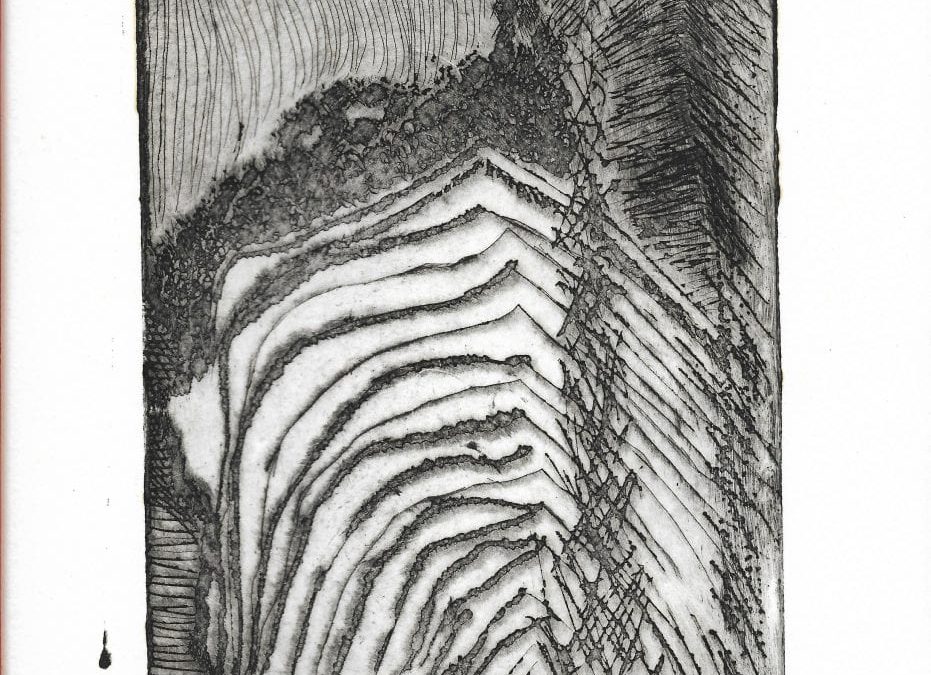Art: Transformation (drypoint etch from the Primordial Geology edition of nine) by John Timothy Robinson
CORMORANT
The cormorant inside my head
peers at the one in my heart.
It shakes its beak,
gestures with its wings
that it’s time to open, to fly.
The cormorant inside my heart
calls back: Run, but a cormorant
can’t run. Hide, it calls,
but such a bird can’t hide.
Fight. It flexes its wings wide.
Previously published in The Moth (Ireland)
About the artist:
Heidi Williamson is a UK-based poet and creative writing tutor. Her two award-winning Bloodaxe collections are Electric Shadow (2011) and The Print Museum (2016). She works with poets world-wide as a Poetry Surgeon for The Poetry Society, teaches for the Poetry School and mentors writers through The Writing Coach. www.
Art: Transformation (drypoint etch from the Primordial Geology edition of nine)
In the artist’s words:
John Timothy Robinson is a traditional, mainstream citizen and holds a Regent’s Degree. He minored in Studio Art: Printmaking. John is also a ten-year educator for Mason County Schools in Mason County, WV. He is a published poet with seventy-six literary works appearing in fifty-nine journals and websites since August 2016 in the United States, Canada and the United Kingdom. In Printmaking, his primary medium is Monotype and Monoprint process with interest in collagraph, lithography, etching and nature prints. John also has an interest in photography and collage art. Published work; “A Grotesque” appears in The Diagram Issue 16.6 2016. “Red Triumph with Daffodils” was published in The Tishman Review 2017. “Gold Fusion” first appeared in New England Review 2017. “Golden Bridge 1,” “The Cook,” “Crying Woman” (block image), “Religious Figure 1,” “Orchard Keeper,” “War Face,” “Candle,” “Iris” (after Ayres Magenta 1), “Pioneer Cabin” (photo) and “Old Car; Mt. Carmel Ridge” (photo) first appeared in New Plains Review print and online 2017. “Blue Abstract” first appeared at Inscape Journal of Brigham Young University 2017. “Leaf Image” was published in Twyckenham Notes 2018. “Synapse Tree” first appeared in Mud Season Review 2018. “Coral I” first appeared in Packingtown Review, Issue 11, winter 2018. “Latent Heart,” “Color Abstract in Pastel Tones,” “Color Field,” “Violet Field Action Painting” and “Golden Bridge” were first published in Empty Mirror in 2018. “Cups Design,” “Golden Bridge 4,” “Still Life; Objects on Table plate photo,” “Pool at the Edge of the Mountain,” “Sphere and Rectangle,” “The Magic Circle” and “Transforming” first appeared in aamora: An International blog for artists, photographers and writers in 2018. “Golden Bridge (red sky 1-5 10-4-2011” was first published at Wise Review 2018. “Still life; Objects on Table” (blue chair, orange wall) first appeared in Duende 2018. “Brick Image” and “The Outhouse” (photos) were first published at Reservoir Journal 2018. “Transform to Lesser Fade” and “Crying Woman” (b/w) first appeared online at Thirteenth Nerve 2018. “Bruce Chapel” (photo) first appeared at River River Writers Circle 2018. Essays on Printmaking; “An Aesthetic for Printmaking” was accepted at Empty Mirror in 2018. Artist Statement for Printmaking; For me, the only valid printmaking today is the process-oriented, research approach. I have an interest in the concept of the painterly print. Sometimes my work in this technique resembles Impressionist or Expressionist painting. Approaching printmaking as a student consistently renews itself and often incorporates much of what we presently know through study of the larger, international historical context. Knowing past techniques and methods has also enabled us to come to greater awareness of their varied cultural origins as well as a greater sense of the nature of art and life for the given individual. This is only possible to know through careful study of past printmakers and artists, their methods and techniques, their innovations and thoughtful insights on art and process. I see no difference between printmaking and any other medium in terms of artistic goals. Printmaking can be executed as a single medium or can incorporate multiple mediums at once. I am always researching, trying to emulate various techniques, learning from them ways to improve my own awareness. Art should arrest human attention, make the viewer question, inspire people and even initiate the learning process beyond the context of the work. “An Aesthetic for Printmaking” sets forth my beliefs as a practicing printmaker today.

